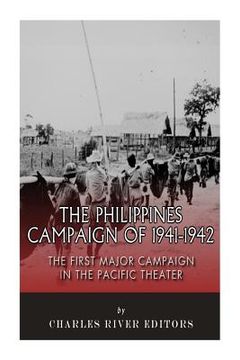The Philippines Campaign of 1941-1942: The First Major Campaign in the Pacific Theater (en Inglés)
Reseña del libro "The Philippines Campaign of 1941-1942: The First Major Campaign in the Pacific Theater (en Inglés)"
*Includes pictures *Includes quotes from soldiers and generals *Includes a bibliography for further reading Those who had decoded and seen the Japanese communications in early December 1941 would not be surprised when they heard about an attack on December 7, 1941. They would, however, be astonished when they heard where that attack took place. Posted on the other side of the world, it was early on the morning of December 8 in the Philippines when American general Douglas MacArthur received news of the Japanese attack on Pearl Harbor hours earlier. With that, it could only be a matter of time before the Japanese attacked the Philippines. Although MacArthur and Allied forces tried to hold out, they could only fight a delaying action, and the Japanese managed to subdue all resistance by the spring of 1942. However, in the aftermath of Japan's successful invasion, as the nation's military strategists began preparations for the next phase of military actions in the theater, their forces had to deal with a critical logistical problem they had not foreseen. The Japanese had to deal with large numbers of Filipino and American soldiers who had surrendered after a lengthy defense in the Bataan peninsula, but they were not prepared for so many prisoners of war because their own military philosophy emphasized rigid discipline and fighting until the end. They could not imagine a situation in which Japanese soldiers would willingly surrender, so they assumed that no other combatants would do so either. On the night of March 12, 1942, MacArthur, his family and closest advisors were smuggled out of Corregidor on PT boats. From there they surged across the black ocean to Mindanao and were picked up by American B-17 bombers. They stealthily flew to northern Australia, a dangerous flight over Japanese-held territory, during which MacArthur casually remarked to General Sutherland, "It was close; but that's the way it is in war. You win or lose, live or die, and the difference is just an eyelash." At Adelaide on March 18, 1942 that MacArthur met the assembled press and told them, "I came through and I shall return." The words would go down in history, and MacArthur would eventually fulfill the vow. Before then, however, prisoners had to contend with the infamous Bataan Death March. Japanese plans to move the POWs from Bataan to prisoner camps in the interior of Luzon estimated that 40,000 American and Filipino soldiers would need to be transported out of the peninsula, but there were actually 78,000 POWs at Bataan, consisting of 66,000 Filipinos and 12,000 Americans. These soldiers were also suffering from disease and malnutrition after fighting on less than 1,000 calories per day toward the end of their defense of Bataan. In essence, the Japanese not only miscalculated the size of the force they would need to move, they also failed to realize the condition of the soldiers as well. Although the Bataan Death March would become synonymous with brutality and are still widely viewed as an atrocity, Japanese plans called for an orderly removal of the prisoners by foot, truck and rail into central Luzon so that they could quickly use Bataan as a launching point to attack the island of Corregidor, thus clearing the entrance to Manila Bay and gaining a key location for naval operations in the Pacific. In fact, Japanese plans did not call for any sort of brutality toward the prisoners; orders coming down from military leaders described potential interactions between Japanese soldiers and POWs as occurring with a "friendly spirit." The Philippines Campaign of 1941-1942: The First Major Campaign in the Pacific Theater chronicles the campaign from the start to its notorious aftermath. Along with pictures of important people, places, and events, you will learn about the Battle of the Philippines like never before.

